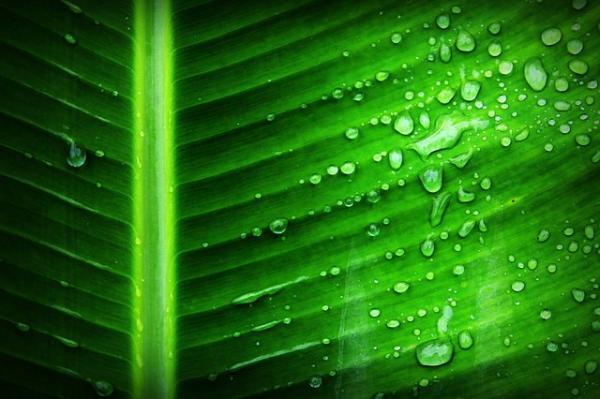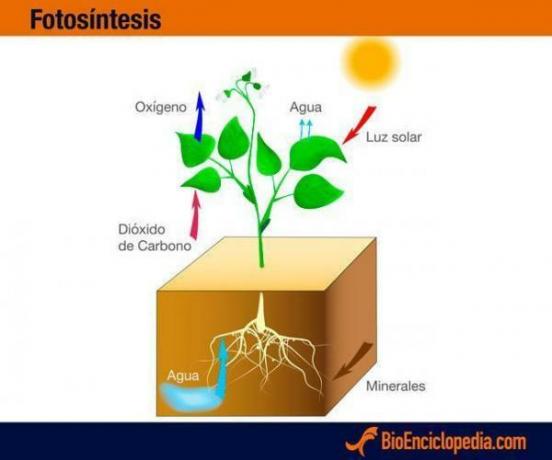The plants' photosynthesis

There is a well-known saying that tells us that nature gives us everything we need and of course we can say that this is totally true. In this lesson from a TEACHER we bring you a summary of plant photosynthesis, a fundamental activity for the existence of life on our planet because it is thanks to this that there is oxygen, a fundamental element for our life. For this reason, we will explain the parts into which the process is divided and we will also describe the factors that harm it.
Within our summary on the photosynthesis of plants we have to know what is the process by which plants feed. For this there is a very necessary substance that is called chlorophyll which is in charge of giving the green color to the plants.
Within the diet, we will find four well differentiated parts:
- Absorption: the roots are responsible for absorbing the water and minerals found under the ground.
- Circulation: Once the first part is done, the transport process is carried out from the roots and through the stem. The water and the minerals are conducted towards the leaves.
- Photosynthesis: the leaves are oriented towards the sun so that the chlorophyll captures the sunlight. Thanks to this and carbon dioxide, the sap is created, which is the plant's food. In that chemical activity the plant discards oxygen, which is expelled back to the environment, thus being an air filter, cleaning the stale air.
- Breathing: Like the rest of living beings, we know that plants also consume oxygen, in this way, while there is sunlight, they breathe, in addition to expelling it into the environment by photosynthesis. And when it is night, we will find that it is the only time when they breathe and consume oxygen without photosynthesis.
Continuing with our summary on plant photosynthesis, we will now stop at the chemical element, by means of which we will try to bring you closer to the process in which they feed.
- At first we have said that chlorophyll is responsible for absorbing sunlight, This is pure energy, which is converted inside the plant into chemical energy.
- With the help of this, it will transform carbon dioxide (CO2), minerals and water (H2O), into carbohydrates (CH2O)
- During this chemical transformation, we will also find that large amounts of oxygen (O2), particles that will be discarded immediately by the plants, being released back into the environment.

To conclude with our Summary on Plant Photosynthesis, we must point out a series of principles without which it would not be possible to carry out this activity:
- Light: It is undoubtedly one of the fundamental elements, because as we have said, plants extract the energy necessary to carry out the function from it. We can say that, in this case, the leaves perform a similar function to solar panels because they absorb energy coming from light and in that way they convert it into energy, both caloric and electrical (in the case of plates solar).
- Water: As in most chemical reactions, water is essential because it is an element where solutions are made. That is why it is so important for all living beings, because in all of them millions of chemical reactions that allow life are carried out every day.
- Carbon dioxide: this element is absorbed by the plant through the stomata (a kind of holes found in the leaves, through which the exchange between the inside and the outside of the same), and it is a very necessary component within this function, because together with the water, they will give the hydrates of carbon.
- Temperature: the ideal temperature for life is set between 20-30ºC, although in some cases, we know that plants can carry out said activity between 0-50ºC, depending of course on the species of each one, and the environmental conditions that may bear. What we have to take into account is that, without an adequate temperature, the chemical process cannot be carried out.

Image: Ecology Today
Thanks to this activity, plants release oxygen into the environment that we use the rest of living beings to be able to live. That is why it is so necessary that the forests and jungles of our planets be conserved, since they are the lungs that the earth has, without them we would not have life.
What's more, they are an excellent air filter for us, since they remove carbon dioxide from the environment, a very important fact, because nowadays and especially in cities, the The air is very stale with the expulsions of this substance into the air caused by the emission caused by the gases of vehicles and other machines.
It is therefore essential to have green places within the cities themselves as they will be air filtration elements that will help other living beings to have a better life.



